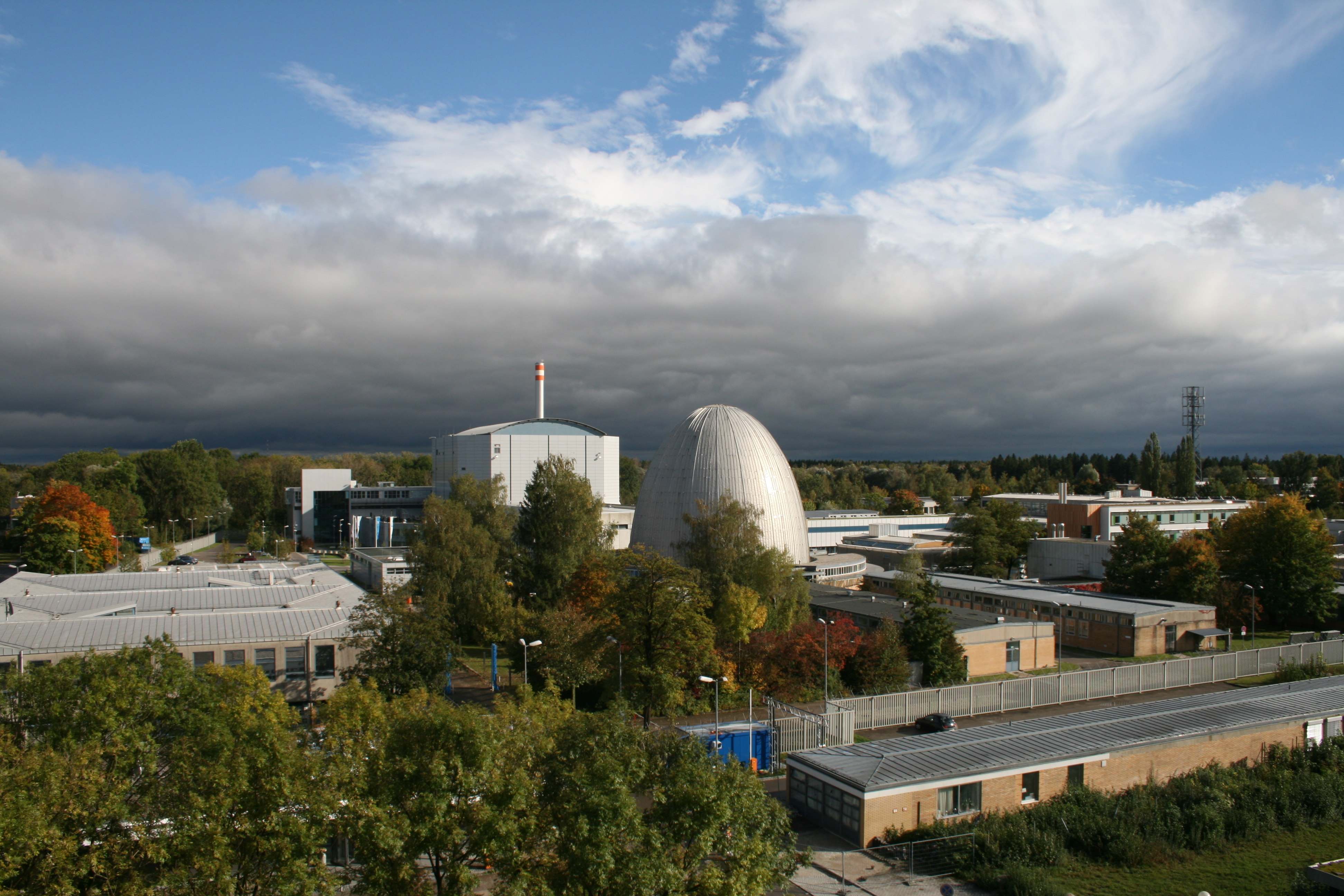|
Neutron Resonance Spin Echo
. Neutron resonance spin echo is a quasielastic neutron scattering technique developed by Gähler and Golub. In its classic form it is used analogously to conventional neutron spin echo (NSE) spectrometry for quasielastic scattering where tiny energy changes from the sample to the neutron have to be resolved. In contrast to NSE, the large magnetic solenoids are replaced by two resonant flippers respectively. This allows for variants in combination with triple axes spectrometers to resolve narrow linewidth of excitations or MIEZE (Modulation of IntEnsity with Zero Effort) for depolarizing conditions and incoherent scattering which are not possible with conventional NSE. Neutron spin echo techniques achieve very high energy resolution in combination with very high neutron intensity by means of a decoupling of the energy resolution of the instrument from the wavelength spread of the neutrons. The energy transfer of the neutrons is encoded in their polarization and not in the change o ... [...More Info...] [...Related Items...] OR: [Wikipedia] [Google] [Baidu] |
Quasielastic Neutron Scattering
Quasielastic neutron scattering (QENS) designates a limiting case of inelastic neutron scattering, characterized by energy transfers being small compared to the incident energy of the scattered particles. In a more strict meaning, it denotes scattering processes where dynamics in the sample (such as diffusive dynamics) lead to a broadening of the incident neutron spectrum, in contrast to, e.g., the scattering from a diffusionless crystal, where the scattered neutron energy spectrum consists of an elastic line (corresponding to no energy transfer with the sample) and a number of well-separated inelastic lines due to the creation or annihilation of phonons with specific energies. The term quasielastic scattering was originally coined in nuclear physics. It was applied to thermal neutron scattering since the early 1960s, notably in an article by Leon van Hove and in a highly cited one by Pierre Gilles de Gennes. QENS is typically investigated on high-resolution spectrometers ( neu ... [...More Info...] [...Related Items...] OR: [Wikipedia] [Google] [Baidu] |
Stray Fields
The demagnetizing field, also called the stray field (outside the magnet), is the magnetic field (H-field) generated by the magnetization in a magnet. The total magnetic field in a region containing magnets is the sum of the demagnetizing fields of the magnets and the magnetic field due to any free currents or displacement currents. The term ''demagnetizing field'' reflects its tendency to act on the magnetization so as to reduce the total magnetic moment. It gives rise to ''shape anisotropy'' in ferromagnets with a single magnetic domain and to magnetic domains in larger ferromagnets. The demagnetizing field of an arbitrarily shaped object requires a numerical solution of Poisson's equation even for the simple case of uniform magnetization. For the special case of ellipsoids (including infinite cylinders) the demagnetization field is linearly related to the magnetization by a geometry dependent constant called the demagnetizing factor. Since the magnetization of a sample at a ... [...More Info...] [...Related Items...] OR: [Wikipedia] [Google] [Baidu] |
Japan Proton Accelerator Research Complex
J-PARC (Japan Proton Accelerator Research Complex) is a high intensity proton accelerator facility. It is a joint project between KEK and JAEA and is located at the Tokai campus of JAEA. J-PARC aims for the frontier in materials and life sciences, and nuclear and particle physics. J-PARC uses high intensity proton beams to create high intensity secondary beams of neutrons, hadrons, and neutrinos. Components J-PARC includes three main parts: the 400 MeV proton linear accelerator, the 3 GeV Rapid Cycling Synchrotron (RCS), and the 30 GeV Main Ring (MR) synchrotron. There are two main experimental areas: the Materials and Life Science Experimental Facility (MLF), where the proton beam from the RCS is used to create beams of either neutrons or muons for further study, and the Hadron Facility (HD), where the beam from the main ring is used to create heavy hadronic particles such as pions and kaons. The main ring beam is also used to create neutrino beams for analysis at the K ... [...More Info...] [...Related Items...] OR: [Wikipedia] [Google] [Baidu] |
Forschungsreaktor München II
The Research Neutron Source Heinz Maier-Leibnitz (Forschungsreaktor München II or FRM II) (german: Forschungs-Neutronenquelle Heinz Maier-Leibnitz) is a leading German research reactor and neutron source, named in honor of the physicist Heinz Maier-Leibnitz who had conducted a highly successful research program at its predecessor, the . Operated by the Technical University of Munich, it is located on its campus in Garching. Overview The FRM II is located in the immediate neighbourhood of FRM I, on the research and university campus near Garching (18 km north of Munich). It is operated by the Technical University of Munich The Technical University of Munich (TUM or TU Munich; german: Technische Universität München) is a public research university in Munich, Germany. It specializes in engineering, technology, medicine, and applied and natural sciences. Establis .... Several other universities and research institutions are taking part in the scientific use. The re ... [...More Info...] [...Related Items...] OR: [Wikipedia] [Google] [Baidu] |
Institut Laue–Langevin
The Institut Laue–Langevin (ILL) is an internationally financed scientific facility, situated on the Polygone Scientifique in Grenoble, France. It is one of the world centres for research using neutrons. Founded in 1967 and honouring the physicists Max von Laue and Paul Langevin, the ILL provides one of the most intense neutron sources in the world and the most intense continuous neutron flux in the world in the moderator region: 1.5×1015 neutrons per second per cm2, with a thermal power of typically 58.3 MW. The ILL neutron scattering facilities allow the analysis of the structure of conducting and magnetic materials for future electronic devices, the measurement of stresses in mechanical materials. It also allows investigations into macromolecular assemblies, particularly protein dynamics and biomolecular structure. It is a world-renowned centre for nanoscale science. History The institute was founded by France and Germany, with the United Kingdom becoming t ... [...More Info...] [...Related Items...] OR: [Wikipedia] [Google] [Baidu] |
National Institute Of Standards And Technology
The National Institute of Standards and Technology (NIST) is an agency of the United States Department of Commerce whose mission is to promote American innovation and industrial competitiveness. NIST's activities are organized into Outline of physical science, physical science laboratory programs that include Nanotechnology, nanoscale science and technology, engineering, information technology, neutron research, material measurement, and physical measurement. From 1901 to 1988, the agency was named the National Bureau of Standards. History Background The Articles of Confederation, ratified by the colonies in 1781, provided: The United States in Congress assembled shall also have the sole and exclusive right and power of regulating the alloy and value of coin struck by their own authority, or by that of the respective states—fixing the standards of weights and measures throughout the United States. Article 1, section 8, of the Constitution of the United States, ratified in ... [...More Info...] [...Related Items...] OR: [Wikipedia] [Google] [Baidu] |
Spallation
Spallation is a process in which fragments of material ( spall) are ejected from a body due to impact or stress. In the context of impact mechanics it describes ejection of material from a target during impact by a projectile. In planetary physics, spallation describes meteoritic impacts on a planetary surface and the effects of stellar winds and cosmic rays on planetary atmospheres and surfaces. In the context of mining or geology, spallation can refer to pieces of rock breaking off a rock face due to the internal stresses in the rock; it commonly occurs on mine shaft walls. In the context of anthropology, spallation is a process used to make stone tools such as arrowheads by knapping. In nuclear physics, spallation is the process in which a heavy nucleus emits numerous nucleons as a result of being hit by a high-energy particle, thus greatly reducing its atomic weight. In industrial processes and bioprocessing the loss of tubing material due to the repeated flexing of ... [...More Info...] [...Related Items...] OR: [Wikipedia] [Google] [Baidu] |
Oak Ridge National Laboratory
Oak Ridge National Laboratory (ORNL) is a U.S. multiprogram science and technology national laboratory sponsored by the U.S. Department of Energy (DOE) and administered, managed, and operated by UT–Battelle as a federally funded research and development center (FFRDC) under a contract with the DOE, located in Oak Ridge, Tennessee. Established in 1943, ORNL is the largest science and energy national laboratory in the Department of Energy system (by size) and third largest by annual budget. It is located in the Roane County section of Oak Ridge, Tennessee. Its scientific programs focus on materials, nuclear science, neutron science, energy, high-performance computing, systems biology and national security, sometimes in partnership with the state of Tennessee, universities and other industries. ORNL has several of the world's top supercomputers, including Frontier, ranked by the TOP500 as the world's most powerful. The lab is a leading neutron and nuclear power rese ... [...More Info...] [...Related Items...] OR: [Wikipedia] [Google] [Baidu] |
Neutron Temperature
The neutron detection temperature, also called the neutron energy, indicates a free neutron's kinetic energy, usually given in electron volts. The term ''temperature'' is used, since hot, thermal and cold neutrons are moderated in a medium with a certain temperature. The neutron energy distribution is then adapted to the Maxwell distribution known for thermal motion. Qualitatively, the higher the temperature, the higher the kinetic energy of the free neutrons. The momentum and wavelength of the neutron are related through the de Broglie relation. The large wavelength of slow neutrons allows for the large cross section. Neutron energy distribution ranges But different ranges with different names are observed in other sources. The following is a detailed classification: Thermal A thermal neutron is a free neutron with a kinetic energy of about 0.025 eV (about 4.0×10−21 J or 2.4 MJ/kg, hence a speed of 2.19 km/s), which is the energy corresponding to the most pr ... [...More Info...] [...Related Items...] OR: [Wikipedia] [Google] [Baidu] |
Hydrogen
Hydrogen is the chemical element with the symbol H and atomic number 1. Hydrogen is the lightest element. At standard conditions hydrogen is a gas of diatomic molecules having the formula . It is colorless, odorless, tasteless, non-toxic, and highly combustible. Hydrogen is the most abundant chemical substance in the universe, constituting roughly 75% of all normal matter.However, most of the universe's mass is not in the form of baryons or chemical elements. See dark matter and dark energy. Stars such as the Sun are mainly composed of hydrogen in the plasma state. Most of the hydrogen on Earth exists in molecular forms such as water and organic compounds. For the most common isotope of hydrogen (symbol 1H) each atom has one proton, one electron, and no neutrons. In the early universe, the formation of protons, the nuclei of hydrogen, occurred during the first second after the Big Bang. The emergence of neutral hydrogen atoms throughout the universe occurre ... [...More Info...] [...Related Items...] OR: [Wikipedia] [Google] [Baidu] |
Superconductors
Superconductivity is a set of physical properties observed in certain materials where electrical resistance vanishes and magnetic flux fields are expelled from the material. Any material exhibiting these properties is a superconductor. Unlike an ordinary metallic conductor, whose resistance decreases gradually as its temperature is lowered even down to near absolute zero, a superconductor has a characteristic critical temperature below which the resistance drops abruptly to zero. An electric current through a loop of superconducting wire can persist indefinitely with no power source. The superconductivity phenomenon was discovered in 1911 by Dutch physicist Heike Kamerlingh Onnes. Like ferromagnetism and atomic spectral lines, superconductivity is a phenomenon which can only be explained by quantum mechanics. It is characterized by the Meissner effect, the complete ejection of magnetic field lines from the interior of the superconductor during its transitions into the ... [...More Info...] [...Related Items...] OR: [Wikipedia] [Google] [Baidu] |
Ferromagnets
Ferromagnetism is a property of certain materials (such as iron) which results in a large observed magnetic permeability, and in many cases a large magnetic coercivity allowing the material to form a permanent magnet. Ferromagnetic materials are the familiar metals noticeably attracted to a magnet, a consequence of their large magnetic permeability. Magnetic permeability describes the induced magnetization of a material due to the presence of an ''external'' magnetic field, and it is this temporarily induced magnetization inside a steel plate, for instance, which accounts for its attraction to the permanent magnet. Whether or not that steel plate acquires a permanent magnetization itself, depends not only on the strength of the applied field, but on the so-called coercivity of that material, which varies greatly among ferromagnetic materials. In physics, several different types of material magnetism are distinguished. Ferromagnetism (along with the similar effect ferrimagnetis ... [...More Info...] [...Related Items...] OR: [Wikipedia] [Google] [Baidu] |





